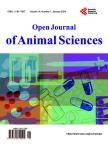Periconceptional growth hormone treatment alters early uterine environment
Periconceptional growth hormone treatment alters early uterine environment作者机构:Department of Medicine Section of Cardiovascular Medicine University of Wisconsin-Madison Madison USA Division of Animal and Nutritional Sciences Davis College of Agriculture Natural Resources and Design West Virginia University Morgantown Morgantown USA Perinatal Research Labs Departments of Obstetrics and Gynecology and Department of Animal Science University of Wisconsin Madison USA
出 版 物:《Open Journal of Animal Sciences》 (动物科学期刊(英文))
年 卷 期:2013年第3卷第2期
页 面:121-126页
学科分类:1002[医学-临床医学] 100214[医学-肿瘤学] 10[医学]
主 题:Growth Hormone Uterine Environment Embryo
摘 要:We have shown that an injection of sustained release growth hormone (GH), given just prior to breeding, results in lambs that are 25% heavier at birth, with an altered body composition as evidenced by an increased abdominal girth, but no difference in crown rump length. The mechanisms by which these differences occur from a single periconceptional injection are not yet known. Therefore, the objective of this experiment was to determine the effect of an injection of GH given prior to breeding on the composition of the uterine luminal environment and the embryo at the time of blastocyst. Ewes were synchronized with two injections of prostaglandin F2α given eight days apart. On the day of the second injection, ewes were randomly assigned to be given an injection of sustained release GH or remain as controls and penned with a ram. On day 6.5 following breeding embryos were collected. Prior to surgery a jugular blood sample was taken to determine plasma progesterone and urea concentration. The uterine content of urea, prostaglandin F2α, prostaglandin E2, transforming growth factor β-1 (TGF β), and nitric oxide metabolites were measured. Collected embryos were differentially stained to calculate a trophectoderm to inner cell mass ratio. The concentration of progesterone in maternal plasma was greater in the treated group compare to controls, but blood urea nitrogen was not different between groups. The uterine content of urea in the GH group was lower than that of the control group. There was a trend for TGF β to be increased in the GH treated group compared to control (P = 0.07). There was no difference (P 0.05) in the total uterine content prostaglandin F2α, prostaglandin E2 or nitric oxide metabolites. The trophectoderm to inner cell mass ratio was not different between treatment groups. Thus, we suggest that the observed difference in fetal development following periconceptional growth hormone administration just prior to breeding may be the result of an alteration



